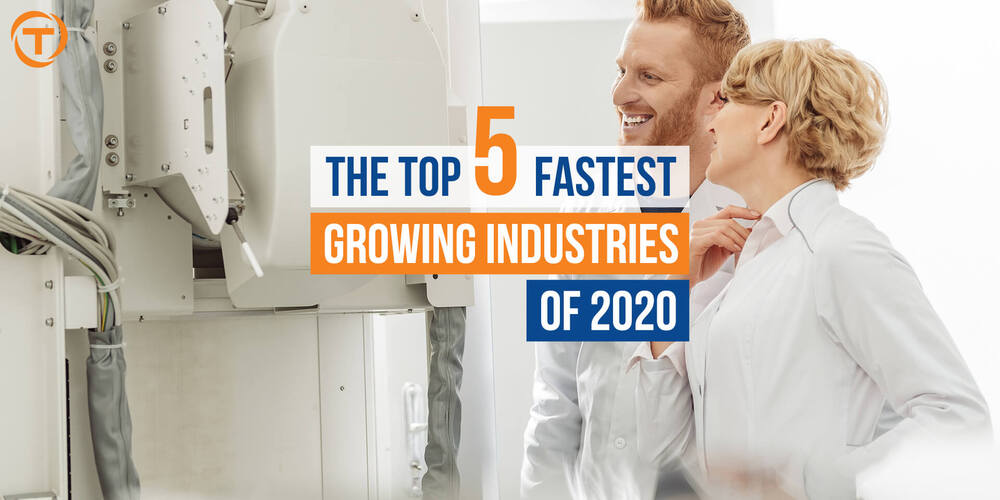It is easy to get caught up in the negativity that is surrounding the current economic climate of late; however, some industries are experiencing exponential growth at this time. We take a look at the top 5
Five fastest-growing industries in Australia that are predicted to continue to rise throughout the year 2020:
The Manufacturing Industry
The manufacturing industry accounts for more than $100 billion of Australia's annual manufacturing output, contributing 48 percent to exports. Innovations in science and technology such as automation and digitisation have changed the operations of the manufacturing industry and will do for years to come.
COVID 19 has made us all rethink local quality, availability and sustainability versus offshoring at a lower cost. While there is much talk about bringing manufacturing back onshore to Australia, it is unlikely to be old-style mass production. Where Australia excels is in specialist firms and technology.
It is expected that Australia's manufacturing sector will be transformed into an export-focused ecosystem that will deliver high-quality, customised solutions making more room for innovative companies along the lines of Resmed, CSL and Cochlear.
A combination of innovation, increased automation, greater reliance on solar and wind power, an increased customer focus on “locally made”, a desire for reusable packaging and veganism along with increased government incentives will all help drive the local manufacturing sector.
In recent times we have seen manufacturers pivot from their core offerings. Breweries are making hand sanitiser, Ford swapping the Mustang line for face shields, and printing companies making work from home desks to name a few.
It may be that Australian businesses are starting to look locally for manufacturers as the downside of decades of offshoring production is being realised. We may soon see a surge of incentive plans to bring back manufacturing segments that are considered critical for national resilience and sustainability. Governments are almost sure to use domestic manufacturing as part of their plan to build up strategic resilience within Australian in the aftermath of the current crisis.
Healthcare Industry
Australia's growing and ageing population are likely to continue to generate strong demand for health services – infrastructure investment, healthcare technology, patient experience and the ageing population all being key growth drivers of the sector.
Hospitals are an increasing priority for governments and healthcare providers to ensure the support of a healthy population. With the government set to deliver more than $30 billion in additional public hospital funding under a five-year National Health Agreement, Australia is set to see a boom in hospital infrastructure development with funding increasing in every state and territory.
Along with this development of infrastructure comes new ways of treating patients with patient-centric care remaining a top trend in healthcare. Patients are welcoming the flexibility in treatment options. They are more open to the idea of being monitored wirelessly for their condition and to consider receiving medical treatment that would traditionally be delivered in a hospital, at home, like chemotherapy - creating new services models.
The ageing population continues to drive innovation and new solutions in healthcare. Government policy reforms like the Aged Care Royal Commission, digital technologies, wearable devices, and smart modular housing is attracting significant investment to revolutionise aged care.
Exporting health care services is also a major trend in the Australian health care industry. Telemedicine and telediagnostics being two of note. New technology advancements like Artificial Intelligence have helped in these efforts, and high demand during the current pandemic is a sign of growth to come.
Energy Industry
According to the Australian Electricity Market Operator, at the start of the year, there were more than 300 market generators, distributors and service providers present in the country.
While traditional fossil fuel sources have dominated Australia’s primary energy consumption, investment in renewable energy generation is contributing to a continuing shift in the energy generation mix. Government policy incentives, elevated electricity prices and declining costs of renewable generation technology being key drivers.
In Australia the energy industry needs to contend with several major fossil fuel burning generators retiring over the next decade, the large variability in our weather and demand, emerging energy market design challenges and long transmission systems on Australia’s East Coast with very low customer densities – all requiring significant investment in both transmission and distribution grids.
As the focus on climate change intensifies, the private sector is also responding with solutions and investment opportunities. Solar, battery storage and energy intelligence are all well underway. The Solar Electricity Generation industry has undergone a period of immense revenue growth over the past five years. Industry revenue is expected to grow at an annualised 102.8% over the next five years to total $298.3 million. This growth has been driven by the development of a multitude of large-scale solar farms, which have increased industry generation capacity from less than 50 MW in 2014 to over 3600 MW in 2019. Industry generation capacity is expected to continue growing in the current year, as an increasing number of solar projects come online.
Australia now has one of the highest solar penetrations in the world, presenting new challenges of how network operators and others manage the integration of renewables into the old transmission network infrastructure requiring additional investment.
In 2020, we will see the most electric vehicles in history sold in Australia, more smart devices deployed in homes and businesses, enabling improved energy efficiency and creating growing markets for these products.
Food Industry
While the hospitality industry has taken one of the biggest hits as a result of COVID-19, several segments of the food industry have seen significant gains.
“Whilst the supermarkets kept their doors open, it was the food and grocery manufacturers and suppliers working around the clock 24/7 that stepped up to keep their shelves stocked with the essential products needed by Australians week after week during the COVID-19 crisis," said AFGC Acting CEO Dr Geoffrey Annison.
AFGC Acting CEO Dr Geoffrey Annison, said that while we make safe, nutritious food here and enough for 75 million people, we also value add to the raw commodities from our farms and sell that to the world. Our exports are worth nearly $35 billion with a strong import trade as well bringing in ingredients to add to the products we make here.
Online food and beverage retailing have been lagging behind other parts of the world; however, it has finally taken off now, becoming the fastest-growing product category in eCommerce. Barriers to entry remain high with the food e-commerce market being dominated by Woolworths and Coles in food product and Dan Murphys, BWS and Liquorland beverage products.
Consumers' increasingly busy lifestyles have reduced the available cooking time for many individuals. Time-poor consumers, especially those living alone, have continued to favour convenient and competitively priced goods. This trend has driven growth in the Prepared Meals Production industry over the past five years.
According to IBISWorld, the fresh ready-meal market here in Australia has experienced an annual growth rate of roughly 3.6% over the last five years. It is now reportedly a $962 million industry.
Technology Industry
The technology sector of Australia accounts for around AUD$122 billion [vi] every year, contributing to 6.6 percent of GDP. While we may not be home to tech giants like Apple, Facebook, Netflix and Google, we have some very impressive technology companies of our own. Atlassian, Appen, Afterpay, Canva, Computershare, ELMO Software, REA Group, Xero, Link Admin, to name a few.
The AI revolution in Australia continues to thrive with the Australian government committing AU$29.9 million over the next four years to fund AI programs. Virtual and augmented reality is projected to become an AU$80 million market by 2025, featuring new virtual technologies. These technologies will aim to enhance communication and training within organisations, improving collaboration outcomes, particularly among the growing millennial workforce.
The local cloud co-market is expected to grow by 20.6%. US data centre giant Equinix is investing AU$225 million in a new Sydney facility to meet the increased demand for computing capacity, while networking group Cisco is pouring AUD$61 million into a new plan to invest in local start-ups, develop critical infrastructure and help digitise government departments. Rapidly growing Indian software industry disrupter Zoho is spending upwards of $AU40 million to establish itself in Australia and is bringing jobs to the regions by choosing to base itself in Byron Bay away from the major Australian cities.
Reported by Deloitte, demand for Information and Communications Technology workers, in particular, will continue to grow by almost 100,000 to 758,700 workers by 2023. By then, 3 million Australian workers are projected to be employed in occupations that use information and communications technology regularly as part of their jobs.
Summary
Australia's fastest-growing industries help create a stable environment for businesses and professionals to explore market opportunities while contributing to the economy, with this comes much-needed employment for the country of Australia. A report by Data61[vii] estimates that improvements to existing industries and the growth of new ones could be worth $315 billion [viii]to the Australian economy over the next decade.
If you are a part of one of these growth industries and need assistance in hiring support, contact a recruitment agency like Trojan Recruitment Group and receive advice from the experts in labour-hire, temp, permanent and contract staff.
References
[vi] http://www.xinhuanet.com/english/2019-09/05/c_138367419.htm
[vii] https://data61.csiro.au/en/Our-Research/Our-Work/Future-Cities/Planning-sustainable-infrastructure/Digital-Innovation
[viii] https://www.industry.gov.au/sites/default/files/2018-12/australias-tech-future.pdf
https://www.iqpc.com/events-austhealthweek/blog/state-of-the-australian-healthcare-industry-report-the-top-trends-driving-australias-healthcare-sector-in-2019-and-beyond
https://www.medicaldirector.com/news/future-of-health/2019/03/report-reveals-top-trends-driving-australias-health-sector-in-2019
https://www.rba.gov.au/publications/bulletin/2020/mar/renewable-energy-investment-in-australia.html
https://www.pwc.com.au/power-utilities/future-of-energy/future-of-energy.pdf
https://www.ampcapital.com/au/en/insights-hub/articles/2019/december/the-future-of-energy-investment-in-australia
https://www.statista.com/outlook/253/107/food-beverages/australia?currency=aud#market-revenue
https://www.afgc.org.au/news-and-media/2020/04/afgc-welcomes-moves-to-strengthen-aussie-manufacturing
https://www.huxley.com/en-au/blog/2019/11/more-to-expect-from-australia-s-tech-scene-in-2020/


